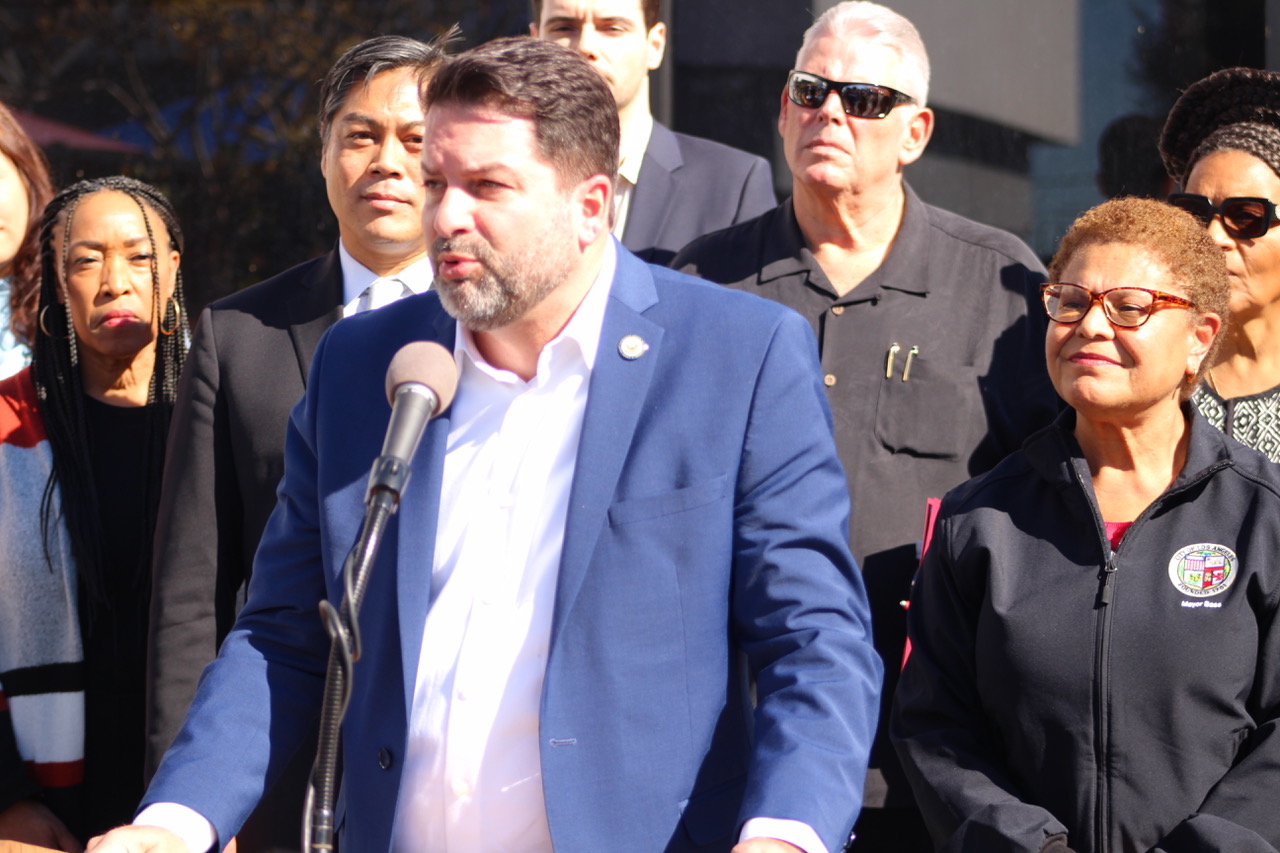
Political Playback: California Capitol News You Might Have Missed
Bo Tefu and Joe W. Bowers Jr. | California Black Media
California State Budget: Legislature Announces Counter Proposal to Gov’s 2024-25 Plan
Last week, members of both houses of the California legislature discussed plans to close the state’s $27.6 billion budget gap, restore funds to build housing, preserve social services, and help the state save money.
The legislative hearings on the budget took place nearly three weeks after Gov. Newsom presented the May revision of his 2024-25 annual spending plan.
On May 30, Assembly Speaker Robert Rivas (D-Hollister) and Senate Pro Tem Mike McGuire (D-North Coast) announced a joint legislative budget proposal on May 30 that saves approximately half of the state’s reserves for future budget years.
“Fixing California’s deficit means making tough choices, so the Assembly came to these negotiations focused on preserving programs that matter most to Californians: lowering the cost of living, expanding affordable housing access and sustaining public services,” said Rivas.
The Democratic Party Budget Committee reviewed the governor’s proposed spending plan to remove various programs and reduce funding for agencies statewide. Newsom’s proposed cuts to public schools across California prompted teachers’ unions to push back with advertisements pressuring the governor to reconsider his budget plans.
The California Teachers Association argued that public schools could lose billions in the next few years resulting in a loss of teachers and resources in the state.
“This agreement is sound and makes the necessary tough decisions meeting the needs of this critical time, all while maintaining our commitment to strong public schools, investing in desperately needed resources in homelessness and workforce housing, health care access, resources to keep our communities fire safe, key climate investments and more,” said McGuire.
H.D. Palmer, a spokesperson for the Department of Finance, said that Gov. Newsom agreed to a temporary arrangement with the teachers’ union to delay spending cuts. The parties agreed to suspend Proposition 98, a law that guarantees an annual minimum amount of funding for public schools.
“The result of that is an agreement we can both support, and that advances two shared goals: avoid multi-billion-dollar cuts to schools in the near term and provide greater predictability for school budgets in the long term,” said Palmer.
The State Senate held budget hearings this week to finalize the plan due by June 15. By state law, once the budget plan is passed, the Governor will have to finalize it by July 1, the beginning of the new fiscal year.
Newsom Admin Takes Steps to Stabilize California’s Troubled Insurance Market
As growing numbers of Insurance companies announce plans to exit California’s insurance market — or cancel customers’ policies — Gov. Gavin Newsom says his administration is taking steps to reverse the trend. Speaking during a news briefing on May 31, Newsom highlighted the plan, which was unveiled as part of a trailer bill on May 28.
Newsom said the proposal speeds up approvals for rate increases and addresses rising costs resulting from incidents like wildfires. Newsom said, under his plan, the Department of Insurance will be required to decide and respond to rate increase requests within 120 days. The plan also calls for streamlining the process for filing for increases; builds in two 330-deay extensions for finalizing rate changes; and provides room for insurers to appeal decisions.
“We need to stabilize this market,” Newsom said. “We need to send the right signals.
Proponents, mainly insurance industry representatives like the Personal Insurance Federation of California, are praising the Governor’s actions while consumer advocates warn that the plan is a threat to public intervention rights California’s Prop 103, a 1988 state law adopted to protect state residents from “arbitrary insurance rates and practices.”
Insurance Commissioner Ricardo Lara thanked Newsom for backing his office’s plan.
“To safeguard the integrity of the insurance market – composed of consumers, homeowners, and business owners – we must fix a system suffering from decades of deferral and delay,” said Lara in a statement. “This measure is one of several parts of a comprehensive plan to enact long-overdue regulatory reforms. The Legislature can do its part to support my reforms by giving this proposal a fair and full consideration, including public input. By enacting this important part of our strategy in statute, the Legislature can help us meet the urgency of the moment.
Lara is working on a longer-term strategy to shore up the insurance market that is expected to be released in December.
LAO Releases Multi-Year Outlook: Modest Budget Deficits to Persist
The state budget deficit is projected to increase, which will require the Governor and Legislature to make more budget cuts over the next few years, California’s non-partisan Legislature Analyst’s Office (LAO) stated in a report last week.
According to the LAO’s multiyear budget report that makes forecasts about the state’s general fund through the 2027-28 fiscal year, the state’s budget problem is $7 billion higher than expected due to lower revenue and spending estimates.
“Under our office’s revenue and spending projections, and assuming the Governor’s May Revision policies are adopted, the budget problem for this year is $7 billion larger,” the report reads. “Put another way, the Legislature would need to take $7 billion in additional budget actions to balance the budget.”
This shortfall requires the Governor to reduce government spending by an additional $7 billion to balance the state’s deficit. However, if the legislature does approve the governor’s May Revisions the budget problems will carry over into the 2025-2026 fiscal year, increasing the existing budget deficit by nearly $10 billion.
California’s budget deficit could be as high as $73 billion, requiring the Legislature to consider harsh budget buts that can help the state economy recover long-term. However, the LAO’s spending estimates are lower than that of the state’s Department of Finance.
“The main reason that our estimates of the state’s operating deficits are slightly smaller than the administration’s is that our estimate of General Fund spending is lower than the administration’s estimates,” stated the LAO in the multiyear budget report.
The LAO’s estimates exclude spending on schools and community colleges, and lower estimated expenditures for Health and Human Services (HHS) programs. Based on the LAO’s estimates, Health programs grow annually by an average of 5.1 percent compared to the Newsom Administration’s estimated 8 percent.
“Our office has little insight into the components of, or assumptions underlying, the administration’s projections in HHS. As a result, we cannot identify the precise source of these differences—or the comparative reliability of our respective estimates — with confidence,” the LAO report stated.
Given the projections, the LAO recommends that the Legislature maintain an overall structure similar to the Governor’s May revisions in the final budget package.
Gov. Newsom: California Is Making Progress in Fentanyl Fight
Last week, Gov. Gavin Newsom announced that state law enforcement authorities seized 5.8 million pills containing fentanyl across the state since the beginning of the year.
The California National Guard Counterdrug Task Force partnered with local and federal law enforcement to seize illegal fentanyl off the streets and at ports of entry along the Southern border, according to Newsom.
Two weeks ago, the State Senate passed the bipartisan Safer California Plan to address the fentanyl crisis and reduce crime in communities statewide.
Senate President pro-Tempore Mike McGuire (D-North Coast) has coauthored 15 bills focusing on crime prevention in local communities. Ten of the bills focus on evidence-based prevention and treatment solutions that address substance abuse and the fentanyl crisis.
Pro Tem McGuire said the bills, “will help curb the deadly fentanyl epidemic,” and reduce community-based crimes that impact people across the state.
CalGuard Major General Matthew Beevers worked alongside law enforcement partners to tackle the fentanyl crisis in the state.
“The volume of seizures we’re enabling and supporting demonstrates our commitment to denying operating capital to drug cartels and making California safer,” said Beevers.
Before the Senate’s package of bills passed, Gov. Newsom compiled a master plan designed to tackle the growing fentanyl and opioid crisis in California. The master plan provided a framework that addresses drug trafficking, supports overdose prevention efforts, and holds the pharmaceutical industry accountable.
“Illegal fentanyl has no place in our neighborhoods. California is tackling this problem head-on by holding drug traffickers accountable and increasing seizures, while at the same time expanding access to substance abuse treatment options and providing lifesaving, affordable reversal medicine to Californians statewide,” said Newsom.
The Newsom administration has also launched an online resource and tools for residents seeking help with prevention and treatment methods for fentanyl and opioid-related substance abuse at Opioids.Ca. Gov
Department of Finance Report: One in Five New Homes in California Are ADUs
Accessory Dwelling Units (ADU) in California have more than doubled in the last half-decade, making the yards of one in five single-family homes into multi-unit properties.
California has experienced a rapid increase in ADUs since the state Legislature lowered building barriers in 2017 to resolve the housing crisis. The number of ADUs has increased from nearly 8,500 units in 2020 to more than 22,800 units in 2024.
According to data from the California Department of Finance, one in five homes is an ADU. Property owners have expanded building projects in their backyards to accommodate family members are be used as rental units.
Since 2017, lawmakers have passed several bills to increase the availability of housing for residents statewide. Assemblymember Phil Ting (D-San Francisco) passed AB 68 in 2019 to help residents acquire ADU permits in no less than 60 days. Lawmakers passed AB 881 the following year, allowing property owners to build ADUs on rental properties and preventing communities from requiring landlords to live on the property.
However, housing advocates argue that the state needs to build a wider variety of housing including apartment buildings. However, expansion plans for affordable housing are restricted by the lack of land near developed areas and local zoning laws that limit building in infill areas.
“Our biggest challenge in California is that so much of our zoning is for single-family homes, which makes it next to impossible to build any new housing,” said Ting.
“This is the one housing product that you can actually build in these single-family neighborhoods,” he said.
These affordable housing units are popular in cities such as Berkeley, San Jose, and Oakland. Developers have helped fuel the increase in ADUs, companies such as BrightSky Residential used new legislation to build a 71-home subdivision with a total of 141 units with no requirement to change zoning on the property. Newer development companies such as Abodu sell pre-manufactured ADUs starting at $228,800 for a 340-square-foot studio. Some companies even offer custom-built ADUs that cost approximately $500 per square foot without water and electricity connection.
The state recently passed legislation that allows homeowners to sell ADUs as condos separate from their properties, starting in July this year.
Public Policy Inst. of California Releases Data on Hate Crimes
Hate crimes against minorities have increased statewide over the last decade with a spike in violent crimes between 2020 and 2022, states a Public Policy Institute of California (PPIC) report.
The recent increase in violent hate crimes is backed by data revealing that victims were targeted based on personal characteristics, including race, ethnicity, and gender. Those violent hate crimes disproportionately affected Black, Latino, and Asian individuals. Incidents of violent hate crimes including assault grew by 791. The number of property-related hate crimes, including vandalism, increased by 314 incidents. In all the incidents reported, 25% of the hate crimes included the use of weapons including knives, handguns, and clubs.
The report stated that violent hate crimes remain underreported. The California Department of Justice is working on plans to invest more money in facilitating the reporting of hate crimes and supporting communities affected most by these incidents.
According to the report between 2019 and 2022, hate crimes targeting Black people tripled, while incidents against Latinos doubled, and attacks against Asians more than tripled in recent years.
“These increases are overwhelmingly driven by violent rather than property crimes,” the report stated.
In 2022, approximately 75% of all reported hate crimes included violent attacks against Black, Latino, or Asian people.
The state has since passed bills to address current and emerging issues related to hate crimes. The Legislature passed AB 485 in 2020, requiring local law enforcement agencies to post monthly updates of hate crimes online. Legislators passed AB 449 in 2023, a law that requires local law enforcement agencies to report suspected hate crimes and provide information that helps report hate crimes to the state attorney general.
Gov. Gavin Newsom launched the “CA vs Hate” campaign, an educational awareness campaign that includes a hotline and online resources for reporting hate crimes. The campaign also provided funds to community-based organizations supporting victims of hate crimes.
“This potential change in reporting behavior, along with increased media attention to the problem, may be partially responsible for the recent uptick in the number of incidents we report on here,” the report stated.






